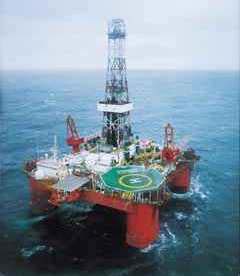Borehole Challenges
The borehole environment is unusually harsh. At a depth of 6 miles the geothermal gradient of the earth can give rise to temperatures of 350°F (175°C) or more, and pressures range to 20,000 psi. Borehole measurement instruments must not only survive but must make quantitative measurements under these conditions. The requirements on electronic components exceed military specifications by a wide margin.
 Borehole NMR instruments must be rugged enough to survive transport in arctic, tropical, desert and marine environments followed by a 3 foot (1 meter) drop onto a steel surface, which typically produces a shock of 100 g. They must survive the abrasion resulting from being dragged over miles of rough rock face in the well bore. They must comply with laws regulating transport by aircraft and helicopter, which is of particular significance for NMR equipment containing strong permanent magnets. The conditions and space constraints are in many respects more severe than those encountered in the exploration of outer space or the ocean bottom.
Borehole NMR instruments must be rugged enough to survive transport in arctic, tropical, desert and marine environments followed by a 3 foot (1 meter) drop onto a steel surface, which typically produces a shock of 100 g. They must survive the abrasion resulting from being dragged over miles of rough rock face in the well bore. They must comply with laws regulating transport by aircraft and helicopter, which is of particular significance for NMR equipment containing strong permanent magnets. The conditions and space constraints are in many respects more severe than those encountered in the exploration of outer space or the ocean bottom.
During the measurements the drilling rig is idle. Since rig charges can be $10,000 to $100,000 per day, oil companies wish to minimize measurement time. This poses a significant constraint on practical operations. Typically, data might be required over a depth interval of 1000 feet (300 meters) or more, with a vertical resolution of one foot (30 centimeters). To be economically viable, the NMR apparatus must move continuously past the formation at a rate of more than 2 inches (5 centimeters) per second. This means that it is necessary to make a complicated measurement in less than six seconds. Compare this to medical Magnetic Resonance Imaging, where the patient has to lie perfectly still for up to a half hour.
|
Logging truck at a wellsite |
Skilled NMR specialists are not available at the well site. The borehole NMR apparatus must be maintained, set up and operated by engineers who also are responsible for other electromagnetic, acoustic and nuclear radiation instruments that are being run simultaneously. Thus there is a large premium on instruments that can operate autonomously under continuously changing conditions.
Borehole measurement instruments generally are transported to the well site on a truck, which also carries 6 miles (10 kilometers) of 7-conductor armored cable used to lower them into the borehole. In present practice, the cable carries 1 kilowatt of power and 500 kilobits per second of digital telemetry. The power required for the NMR measurement is around 100 watts, apportioned among transmitter, receiver, auxiliary sensors and a downhole computer.
This content has been re-published with permission from SEED. Copyright © 2025 Schlumberger Excellence in Education Development (SEED), Inc.


